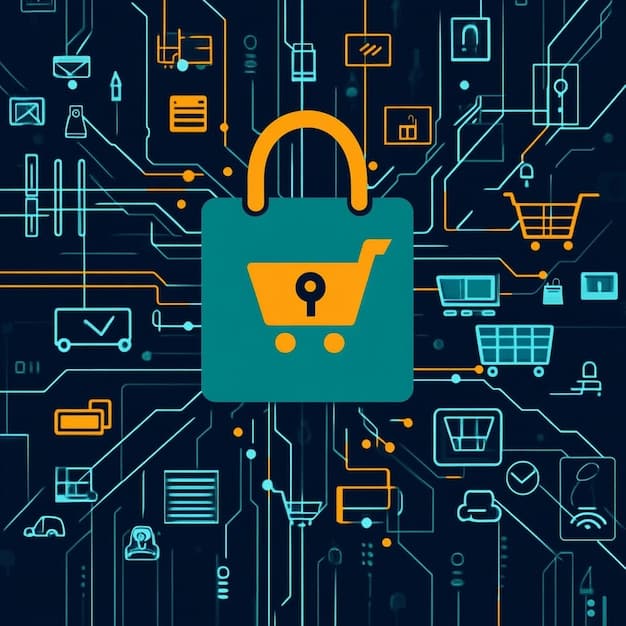January 2025 E-commerce Security Updates: US Business Impact

The upcoming January 2025 e-commerce platform security updates are poised to significantly impact US-based businesses by mandating stricter data protection protocols and fraud prevention measures, requiring immediate adaptation to avoid compliance penalties and maintain customer trust.
As January 2025 approaches, US-based e-commerce businesses are bracing for significant changes. The new e-commerce platform security updates are not merely technical adjustments; they represent a fundamental shift in how online transactions, customer data, and overall platform integrity will be managed. This comprehensive overview aims to dissect these upcoming regulations, exploring their origins, their detailed implications for various business sizes, and the proactive strategies necessary for seamless compliance and sustained success in a rapidly evolving digital landscape.
Understanding the Genesis of the January 2025 Security Updates
The digital economy has grown exponentially, bringing unprecedented convenience but also heightened risks. Data breaches, cyberattacks, and privacy violations have become increasingly common, eroding consumer trust and costing businesses billions. This escalating threat landscape is the primary driver behind the January 2025 e-commerce security updates, reflecting a global trend towards stronger regulatory frameworks.
Historically, security measures were often reactive, implemented after a breach occurred. However, the new updates emphasize a proactive, preventative approach, mandating minimum security standards across all e-commerce platforms handling US consumer data. These standards are not arbitrary; they stem from evolving international best practices and a concerted effort to harmonize security protocols, aiming to create a more secure and resilient online ecosystem for both businesses and consumers.
The Regulatory Landscape: A Collaborative Effort
The January 2025 updates are a confluence of various regulatory bodies and industry standards. They draw heavily from existing frameworks like the Payment Card Industry Data Security Standard (PCI DSS), the California Consumer Privacy Act (CCPA), and emerging federal data protection initiatives. This combined approach ensures a broad scope, covering not only transactional security but also comprehensive data privacy and integrity.
- PCI DSS Alignment: Many new requirements expand upon PCI DSS, pushing for stronger encryption and tokenization for cardholder data.
- Data Privacy Enhancements: Reflecting CCPA principles, stricter rules around data collection, storage, and anonymization are introduced.
- Federal Initiatives: Anticipating future federal privacy laws, these updates lay groundwork for a unified national security posture.
The goal is to establish a robust baseline that protects consumers while providing businesses with clear guidelines. The updates signal a move towards greater accountability, where platforms and merchants share responsibility for safeguarding digital interactions.
Ultimately, these new regulations are a critical step towards maturing the e-commerce sector. They acknowledge that security is not a luxury but a fundamental necessity for continued growth and consumer confidence. Businesses that embrace these changes early will not only comply but also gain a competitive edge by demonstrating a superior commitment to data protection.
Key Pillars of the New Security Mandates for US E-commerce Platforms
The January 2025 updates are structured around several core principles, each designed to fortify different aspects of e-commerce security. Understanding these pillars is crucial for US businesses to assess their current capabilities and identify areas requiring immediate attention. These mandates aim to create a multi-layered defense against evolving cyber threats, from sophisticated attacks to simple human errors.
One of the most significant changes is the heightened emphasis on data encryption, not just in transit but also at rest. This means that customer data stored on servers must be encrypted, making it unreadable to unauthorized parties even if a breach occurs. This “defense in depth” strategy significantly raises the bar for data protection, moving beyond mere network perimeter security.
Enhanced Data Encryption and Tokenization
The new mandates explicitly require advanced encryption standards for all sensitive customer information, including payment details, personally identifiable information (PII), and login credentials. Tokenization, where sensitive data is replaced with a unique, non-sensitive identifier, is strongly encouraged for payment processing. This reduces the footprint of actual card data on merchant servers.
- End-to-End Encryption: Mandated for data both in transit (e.g., during checkout) and at rest (stored on servers).
- PCI DSS 4.0 Compliance: The updates align closely with PCI DSS 4.0, pushing for more granular controls and continuous monitoring.
- Tokenization as Best Practice: Encouraged for all payment transactions to minimize risk exposures.
These measures collectively aim to make data breaches less impactful, as stolen data would be largely unintelligible without the decryption keys or token mapping.

Multi-Factor Authentication (MFA) and Access Controls
Strengthening access controls is another cornerstone of the new regulations. MFA will become a mandatory feature for customer logins and administrative access to e-commerce platforms. This adds an extra layer of security beyond just a password, significantly reducing the risk of unauthorized access due to compromised credentials.
Furthermore, businesses are expected to implement granular role-based access controls (RBAC), ensuring that employees only have access to the data and functionalities absolutely necessary for their roles. This minimizes internal threats and limits the potential damage from a rogue employee or an account takeover.
Regular Security Audits and Vulnerability Assessments
The updates mandate periodic security audits and vulnerability assessments. These are no longer optional best practices but required components of a robust security posture. Businesses must regularly scan their platforms for weaknesses, conduct penetration testing, and address identified vulnerabilities promptly.
Documentation of these audits and remediation efforts will be critical. Regulatory bodies will expect to see proof of continuous security improvement and a proactive stance against emerging threats. This shifts the responsibility onto businesses to actively maintain a secure environment, rather than just reacting to incidents.
In essence, these pillars transform security from a checkbox exercise into an ongoing, integral part of e-commerce operations. Businesses must embed security practices into their daily workflows and technological infrastructure to meet the demands of this new era.
Impact on Different US-Based E-commerce Business Sizes
The January 2025 e-commerce security updates will not affect all US-based businesses uniformly. While the core mandates apply across the board, the scale of necessary adjustments and the resource allocation will vary significantly depending on the size and operational model of the e-commerce entity. Understanding these differentiated impacts is key to strategic planning and resource deployment.
Larger enterprises, with their existing complex infrastructures and dedicated security teams, may find the transition challenging due to the sheer volume of systems requiring updates. However, they typically possess the financial and human resources to manage such a transition. Conversely, small to medium-sized businesses (SMBs) might face a steeper climb, often lacking specialized security personnel or sizable budgets for extensive overhauls.
Small to Medium-Sized Businesses (SMBs): A Significant Hurdle
For many SMBs, the immediate impact could be substantial. They often rely on off-the-shelf e-commerce solutions or smaller, less robust platforms. The new requirements for encryption, MFA, and regular audits may necessitate investments in new technologies, external compliance services, or significant retraining of existing staff.
- Increased Operational Costs: Implementing new security features, software, and compliance tools will incur direct costs.
- Demand for External Expertise: Many SMBs will need to contract cybersecurity consultants or managed security service providers (MSSPs).
- Learning Curve: Staff will require training on new protocols and security best practices, potentially impacting productivity initially.
The good news is that many leading e-commerce platforms (like Shopify, BigCommerce, etc.) are already working to integrate these updates into their core offerings, which could alleviate some burden for their users. However, businesses hosted on older or custom platforms will need to take a more hands-on approach.
Large Enterprises: Complexities of Scale
Large enterprises, while better resourced, face challenges stemming from their vast and often distributed digital ecosystems. Integrating new security standards across multiple platforms, global supply chains, and legacy systems can be a monumental task. The risk of overlooking a vulnerable point within a sprawling infrastructure is high.
Their concerns will likely revolve around the smooth integration of new protocols with existing systems, ensuring no disruption to services, and managing the compliance across various internal departments and third-party vendors. The key will be meticulous project management and comprehensive risk assessment.
Regardless of size, the underlying message is clear: procrastination is not an option. Early assessment, budgeting, and strategic planning are paramount for all US-based e-commerce businesses hoping to navigate these updates successfully.
Navigating Compliance: Strategies for US E-commerce Businesses
Achieving compliance with the January 2025 e-commerce security updates requires a methodical and proactive approach. Simply reacting to problems as they arise will not suffice and could lead to significant penalties, reputational damage, and loss of customer trust. Instead, US businesses must adopt a strategic mindset, integrating security into every facet of their operations.
Crucially, compliance should not be viewed solely as a regulatory burden but as an opportunity to strengthen business resilience and enhance customer confidence. A robust security posture can become a competitive differentiator in a market increasingly sensitive to data privacy and digital safety.
Conducting a Comprehensive Security Audit and Gap Analysis
The first step is to thoroughly understand your current security landscape. This involves a detailed audit of all e-commerce systems, data handling practices, third-party integrations, and internal processes. Identify where your current practices fall short of the new January 2025 mandates.
- Platform Assessment: Evaluate your e-commerce platform’s native security features and update roadmaps.
- Data Flow Mapping: Understand how customer data enters, moves through, and is stored within your systems.
- Third-Party Vendor Review: Ensure all third-party integrations (payment gateways, analytics, advertising partners) are also compliant.
This gap analysis will provide a clear roadmap for remediation, prioritizing the most critical vulnerabilities and non-compliant areas. It’s an essential baseline for all subsequent actions.
Implementing Technical and Procedural Upgrades
Once gaps are identified, the next phase involves implementing the necessary technical and procedural changes. This could range from upgrading platform versions to deploying new encryption solutions, configuring multi-factor authentication, and revising internal security policies.

Beyond technology, procedural changes are equally vital. Employee training on new security protocols, incident response plans, and data protection best practices will be critical. Human error remains a leading cause of security breaches, so a well-informed workforce is a powerful defense.
Consider automating security tasks where possible, such as routine vulnerability scans or log monitoring. Automation reduces manual effort and increases the consistency and frequency of security checks, improving overall resilience.
Continuous Monitoring and Adaptability
Compliance is not a one-time event; it’s an ongoing process. The digital threat landscape is constantly evolving, and so too must your security measures. Establish systems for continuous monitoring of security events, regular vulnerability scanning, and periodic re-evaluation of your compliance posture.
Stay informed about industry best practices and potential future regulatory changes. E-commerce businesses must foster a culture of security, where vigilance and adaptability are core values. This proactive, continuous approach will ensure long-term compliance and build enduring trust with your customer base.
The Role of E-commerce Platforms and Third-Party Vendors
The success of US-based e-commerce businesses in adapting to the January 2025 security updates is intrinsically linked to the actions and support provided by their chosen e-commerce platforms and third-party vendors. These external partners play a pivotal role, often providing the very infrastructure and tools upon which businesses operate. Understanding their responsibilities and capabilities is crucial for planning your own compliance strategy.
Many e-commerce platforms are actively working to update their core systems to meet these new standards, aiming to provide their users with compliant environments by default. However, the level of built-in compliance and the ease of transition will vary significantly between platform providers. Businesses must engage proactively with their platform providers to understand their readiness.
Platform Providers: Shared Responsibility and Shared Solutions
Leading e-commerce platforms (e.g., Shopify, Magento, BigCommerce, WooCommerce) recognize the importance of these updates and are typically investing heavily in their security infrastructure. They are expected to:
- Roll out Patches and Updates: Implement necessary encryption upgrades, MFA capabilities, and secure storage solutions.
- Provide Documentation and Guidance: Offer clear instructions, checklists, and resources to help merchants understand their compliance obligations.
- Offer Compliant Features: Integrate features that assist merchants in meeting specific requirements, such as enhanced fraud detection or data anonymization tools.
- Enhance API Security: Secure the interfaces through which third-party applications connect to merchant data.
While platforms will handle infrastructure-level security, merchants remain responsible for how they configure their stores, manage customer data, and integrate third-party apps. It’s a shared responsibility model, requiring active participation from both sides.
Third-Party Vendors: A Critical Link in the Security Chain
Beyond the core e-commerce platform, businesses often utilize a myriad of third-party vendors for payment processing, shipping, analytics, marketing, and customer relationship management. Each of these vendors represents a potential vulnerability and must also be compliant with the new security mandates.
Businesses need to:
- Vet Vendors Thoroughly: Ensure all third-party solution providers have robust security postures and can demonstrate compliance with relevant standards.
- Review Service Level Agreements (SLAs): Confirm that vendor agreements include explicit clauses regarding data security, breach notification, and liability.
- Limit Data Sharing: Only share the absolute minimum amount of customer data necessary with each vendor.
A single weak link in the chain can compromise the entire security posture. Proactive communication and due diligence with all third-party partners are essential to maintaining an end-to-end secure environment. Failure to do so could result in fines, reputational damage, and loss of customer trust, even if your own platform is perfectly secure.
Potential Challenges and Opportunities for US Businesses
The January 2025 e-commerce security updates present a dual landscape of challenges and opportunities for US-based businesses. While the immediate focus might be on the hurdles of compliance, a longer-term perspective reveals significant strategic advantages for those who embrace these changes not as burdens, but as catalysts for growth and differentiation.
The initial investment in time, resources, and technology can certainly be daunting, particularly for smaller businesses. However, this investment lays the groundwork for a more resilient, trustworthy, and ultimately more successful online operation. Ignoring these changes, on the other hand, carries far greater risks than the cost of compliance.
Challenges: Costs, Complexity, and Skills Gaps
The most immediate challenges include:
- Financial Investment: Upgrading technology, subscribing to new services, and hiring cybersecurity experts can be costly.
- Operational Disruptions: Implementing new systems and training staff may temporarily impact workflows and productivity.
- Technical Complexity: Understanding and integrating advanced security protocols can be technically challenging for businesses without dedicated IT security teams.
- Skills Gap: A shortage of skilled cybersecurity professionals could make it difficult for businesses to find the expertise they need.
Businesses must carefully budget for these challenges and allocate resources effectively. Proactive planning is vital to mitigate potential disruptions and ensure a smooth transition.
Opportunities: Enhanced Trust, Competitive Advantage, and Innovation
Beyond the challenges, the updates open doors to significant opportunities:
- Increased Customer Trust: Demonstrating a strong commitment to security builds consumer confidence, which is a powerful driver in today’s privacy-conscious market.
- Competitive Differentiation: Businesses that are early adopters and market their robust security practices can stand out from competitors. Security can become a unique selling proposition.
- Reduced Risk of Breaches: A stronger security posture naturally reduces the likelihood and impact of cyberattacks, saving potential future costs, legal fees, and reputational damage.
- Streamlined Operations: The process of auditing and upgrading systems often leads to discovering and rectifying other operational inefficiencies.
- Innovation in Security Solutions: The demand for enhanced security will drive innovation in new tools and services, benefiting the entire e-commerce ecosystem.
By viewing these updates as an integral part of ongoing business development rather than an isolated compliance task, US e-commerce businesses can transform a regulatory requirement into a strategic asset. Future-proofing your operations against cyber threats is not just about avoiding penalties; it’s about building a sustainable and successful business model for the digital age.
Best Practices for Maintaining Ongoing E-commerce Security Post-January 2025
Achieving compliance with the January 2025 e-commerce security updates is merely the starting point. Sustaining a robust security posture requires ongoing vigilance, continuous adaptation, and the embedding of security best practices into the very DNA of your US-based e-commerce business. Cybersecurity is not a destination but a continuous journey.
Neglecting security after initial compliance can quickly render your efforts obsolete, as new threats emerge and vulnerabilities are discovered. A proactive, adaptive strategy is essential for protecting your business, your customers, and your reputation in the long run.
Implementing a Culture of Security
Security is everyone’s responsibility, not just the IT department’s. Fostering a security-aware culture across the entire organization is paramount. This involves:
- Regular Employee Training: Educate staff on the latest cyber threats, phishing scams, strong password practices, and data handling protocols.
- Clear Policies and Procedures: Establish comprehensive security policies that are easily understandable and regularly reinforced.
- Incident Response Plan: Develop and regularly test a clear, actionable plan for responding to security incidents, including communication strategies.
Employees are often the first line of defense, and a well-trained workforce can significantly reduce the risk of successful cyberattacks.
Leveraging Advanced Security Technologies
Beyond basic compliance requirements, consider adopting advanced security technologies to further protect your e-commerce operations:
Next-generation firewalls and intrusion prevention systems can detect and block sophisticated network attacks. Advanced encryption and data loss prevention (DLP) solutions ensure sensitive information never leaves secure environments without authorization. Machine learning and AI-powered threat detection tools can identify anomalous behavior that might indicate a nascent attack, often in real-time.
Consider implementing Security Information and Event Management (SIEM) systems to aggregate and analyze security logs from across your various platforms. This provides a centralized view of your security posture and helps identify patterns of malicious activity that might otherwise go unnoticed.
Regular Monitoring and Adaptability
The threat landscape is dynamic. What is secure today may be vulnerable tomorrow. Therefore, ongoing monitoring and a commitment to adaptability are crucial:
- Continuous Vulnerability Management: Regularly scan your systems for new vulnerabilities and apply patches promptly.
- Threat Intelligence: Stay informed about emerging threats and attack vectors relevant to the e-commerce sector.
- Periodic Re-Audits: Conduct regular, independent security audits to ensure continued compliance and identify any new weaknesses.
By treating security as an iterative process of assessment, implementation, and refinement, US e-commerce businesses can ensure they remain ahead of malicious actors and continue to provide a safe and trusted environment for their customers.
Forecasting Beyond 2025: The Future of E-commerce Security in the US
While the January 2025 security updates represent a significant milestone, they are by no means the final word in e-commerce cybersecurity. The digital landscape is in perpetual motion, driven by technological advancements, evolving threat actors, and an increasing global interconnectedness. For US-based e-commerce businesses, looking beyond 2025 is not just prudent; it’s essential for long-term strategic planning and resilience.
Tomorrow’s security challenges will likely transcend current paradigms, demanding foresight and continuous innovation. Businesses that anticipate future shifts in regulatory frameworks, technological capabilities, and cybercriminal tactics will be best positioned to thrive in an increasingly complex environment.
Emerging Technologies and Their Security Implications
Several technological trends are poised to redefine e-commerce security in the coming years:
- AI and Machine Learning: While currently used for threat detection, AI will increasingly power proactive defense systems, predicting attacks before they occur. However, it also presents new attack vectors (e.g., AI-powered phishing).
- Quantum Computing: The advent of quantum computing threatens to break current encryption standards, necessitating a shift to “post-quantum cryptography.” This is a long-term, but critical, consideration.
- Blockchain Technology: Distributed ledger technologies could offer new ways to secure transaction records and supply chains, enhancing data integrity and transparency.
Businesses should monitor these developments and assess how they might integrate these technologies to enhance security or how they might need to adapt to new vulnerabilities introduced by them.
Evolving Regulatory Landscape and Global Harmonization
The trend towards stronger data privacy and security regulations is global and will continue. We can anticipate:
Further expansion of federal data privacy laws in the US, potentially leading to a national standard that unifies state-level regulations like CCPA. Greater harmonization between international security standards (e.g., GDPR, CCPA, and new US federal laws) to simplify compliance for businesses operating across borders. Increased focus on supply chain security, extending security requirements to all partners involved in the e-commerce ecosystem, from logistics to software providers.
Staying abreast of these legislative developments will be crucial for maintaining compliance and avoiding future penalties. This requires a proactive legal and compliance team, or expert external guidance.
The Imperative of Proactive Security by Design
Ultimately, the future of e-commerce security dictates a move towards “security by design.” This means embedding security considerations from the very inception of any new product, service, or system, rather than trying to bolt it on as an afterthought.
Businesses that prioritize security as a core component of their innovation strategy will not only meet future compliance requirements but will also build an inherent resilience against inevitable future threats. This philosophical shift will differentiate leaders in the e-commerce space, ensuring sustainable growth and unwavering customer confidence in an ever-evolving digital world.
| Key Aspect | Brief Description |
|---|---|
| 🔒 Enhanced Encryption | Mandates stronger data encryption for data at rest and in transit, vital for protecting sensitive customer information. |
| 🔑 Multi-Factor Authentication | Requires MFA for logins and administrative access, significantly reducing unauthorized access risks. |
| ⚙️ Regular Security Audits | Businesses must conduct periodic security assessments and address vulnerabilities promptly. |
| 🤝 Vendor Compliance | Ensuring all third-party vendors also comply with new security standards is essential for end-to-end protection. |
Frequently Asked Questions About 2025 E-commerce Security Updates
The primary goals are to enhance overall cybersecurity, protect consumer data, and minimize fraud in online transactions. These updates aim to establish a stronger, more standardized security baseline for all US-based e-commerce operations, fostering greater trust among consumers and mitigating financial losses due to breaches.
Yes, while the mandates apply universally, small businesses may face greater challenges due to limited resources and expertise. They might need significant investment in new technologies or external consultants. Larger enterprises face complexity in integrating updates across vast systems, but typically have more resources to manage the transition.
“Security by design” means embedding security considerations from the initial stages of product or system development, rather than adding them later. It is crucial because it creates an inherently more secure system, reducing vulnerabilities from the outset and making compliance and ongoing security maintenance more efficient and effective.
Businesses should conduct thorough due diligence when selecting vendors, reviewing their security practices and certifications. It’s essential to include specific security and compliance clauses in SLAs and to regularly audit vendor performance. Limiting the data shared with each vendor also reduces potential exposure.
Long-term benefits include enhanced customer trust, a strong competitive advantage, and reduced risk of costly data breaches and reputational damage. Compliance fosters a more resilient and secure operational environment, paving the way for sustainable growth and innovation in the evolving e-commerce landscape.
Conclusion
The January 2025 e-commerce platform security updates mark a pivotal moment for US-based businesses, fundamentally reshaping the landscape of online commerce. These mandates underscore a critical shift toward proactive, comprehensive cybersecurity, moving beyond mere compliance to foster a culture of digital trust and operational resilience. While the journey to adapt will undoubtedly present challenges, from financial investments to technical complexities, the opportunities for enhanced customer confidence, competitive differentiation, and long-term business sustainability are significant. By embracing these changes strategically, engaging diligently with platform providers and third-party vendors, and committing to continuous security improvement, US e-commerce businesses can not only meet regulatory demands but also fortify their future in the dynamic digital economy. The path forward requires vigilance, adaptability, and a deep understanding that robust security is not an expense, but an indispensable investment in enduring success.





